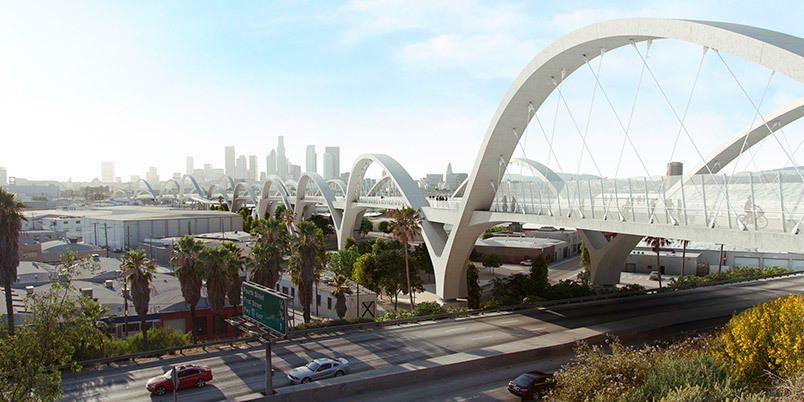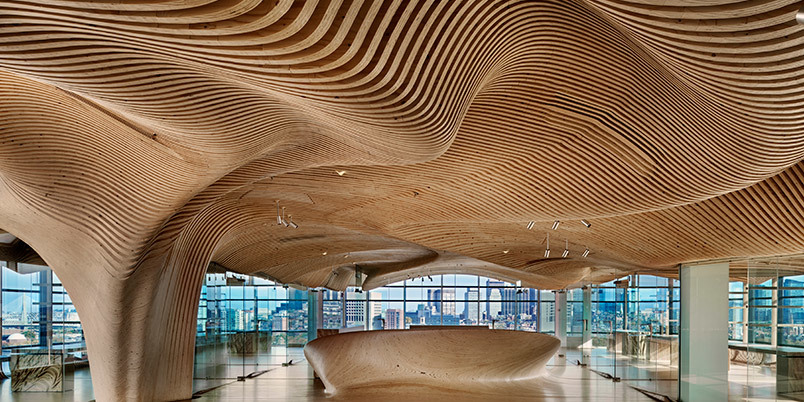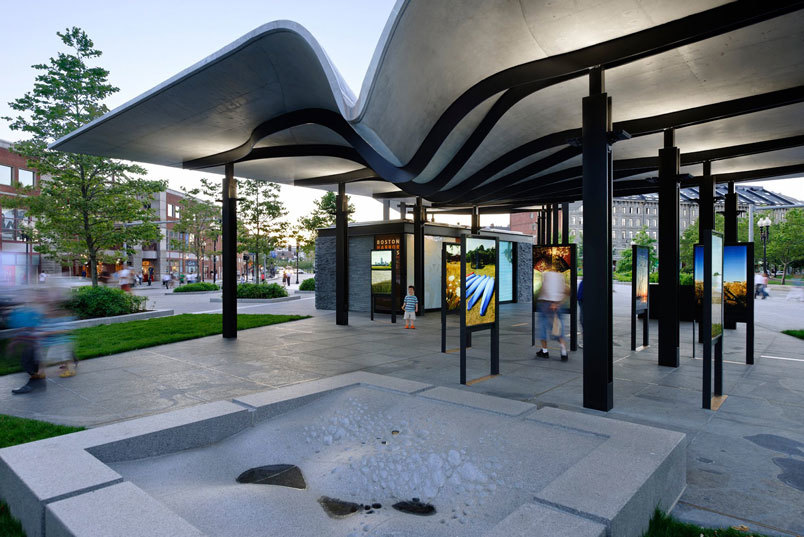Ryan Salvas
Name: Ryan Salvas
Job title and company: Design director, C.W. Keller & Associates (CWKA)
Degree(s): BArch, Rensselaer Polytechnic Institute; MS, Center for Architecture Science and Ecology (CASE), Rensselaer Polytechnic Institute
Professional interests:
My thesis has remained constant for nearly a decade: how to continue to leverage technology in the way we design and build. My interests lie in understanding and presenting technology as a critical, multilayered system that suggests technology in the broadest, most inclusive sense of the word "system."

Above: Rendering: Michael Maltzan Architects.
What are you working on now?
Everything from a three-quarter-mile-long, cast-in-place bridge in Los Angeles to replace the Sixth Street Bridge to a series of precast ultra-high-performance concrete benches for Syracuse University. We are working on fitting out Google's new space in Cambridge, Massachusetts, and some exciting research initiatives with WeWork. I am working on a project with Mack Scogin Merrill Elam Architects out of Atlanta, Georgia, helping them design a renovation of the Harvard Cabot Science Library. It has been a great process to work closely with the architects, owners, and contractors.
What inspired you today?
Personally, I am inspired by my family. My wife and my children really are everything. I look forward to seeing the world through their eyes. I am also inspired by whatever car or truck I am working on. I have always loved old cars and find working on and driving them very rewarding. They are simple enough that you can put in a day’s work and see physical evidence of your progress. Right now I am working on a 1973 International Harvester Scout II. Whenever I drive it to work, like I did today, I am amazed at what a calming effect it has on me; I am a more level-headed and inspired designer.
What architectural buzzword would you kill?
Having spent a few good years teaching, I would kill the word “interdisciplinary.” In an academic setting, interdisciplinary research is great theoretically, but flawed in practice. Schools look to hire interdisciplinary researchers to help boost and distribute money earned from grants to schools that are not traditionally research-rich, like schools of architecture. But a research-based tenure process only puts emphasis on individual achievement, so interdisciplinary research, which capitalizes on collaboration, falters when it comes to quantifying and qualifying individual roles within a research program. It is a system in need of a revamp.
When you’re working, do you discuss or exchange ideas with your colleagues?
As fabricators dealing with very complex builds, we are often building and designing something that doesn’t have a precedent. For me and my team, the biggest asset we have is the shop floor. At C.W. Keller, we are engineering- and fabrication-heavy; 90 percent of the work that we engineer, we also fabricate and assemble. On any given day, our team is down in the shop talking through ideas with Computer Numerical Control (CNC) operators and shop technicians to help develop digital craftsmanship. The evolution of craftsmanship in a fully CNC-fabricated era is through leveraging computation to deliver quality and efficiency. That takes a level of understanding between digital gymnastics and old school experience that's hard to find these days. I am very lucky to work in an environment that appreciates the two worlds.
What are you reading?
I really enjoy reading science fiction and fantasy novels. Right now, I am reading two books. I am trying to finish Neuromancer by William Gibson, but am way more engaged by Next by Michael Crichton. Neuromancer is such a mental investment that I have a hard time getting through more than a few pages at night without falling asleep. Crichton is a much lighter read and it is my current travel book. I travel quite a bit for work, so my go-to novels are quick reads that I can blow through on an airplane or train ride to pass the time. Other than that, I can usually be found reading books to my kids.

Above: Photo: Anton Grassl | ESTO.
Do you sketch by hand or digitally?
Digitally. It is more in tune with the way I think through problems. When I was in school, there was not a ton of emphasis on hand-drawing, and because I had no knowledge of the profession before entering college, I never really questioned it. I actually believe my brain learned to think conceptually through design software. To this day, I have a hard time with drawing by hand because it feels too slow.
Has your career taken you anywhere you didn’t expect?
Absolutely. My career path has been odd, in that I have never worked in architecture, but always parallel to it—either in technology, product design, construction, or some combination thereof. Right out of architecture school, I went to work as a façade consultant at Front Inc. in New York, which seemed like creative suicide to many. But I have never had more influence on design than when I was on that side of the table. After that, I worked at SHoP Architects in a more traditional architectural role. Then my wife and I, in search of a simpler life, packed up and moved to Alabama so I could teach at Auburn University. This was an amazing change of pace personally, but professionally it was a bit too slow, and I found myself yearning for balance. Which is why I found myself heading for New Hampshire to work at C.W. Keller. It is the convergence of all of the little things I have enjoyed about each of my disparate experiences over the years: fast pace, quick turnaround, high-profile projects, and design leverage.
Can design save the world?
In the words of the great Ian Malcolm: "Let's be clear. The planet is not in jeopardy. We are in jeopardy. We haven’t got the power to destroy the planet—or to save it." I think design is very important, to the point where I have made it my career, and I agree that good design can solve problems, but I do not believe designers are problem solvers. I think it’s dangerous to call them that. There are no superheroes here—except Elon Musk. That guy is actually a superhero.

Above: Photo: Chuck Choi.
Who or what deserves credit for your success?
In college, I was lucky to have William Massie as a professor. He pushed the convergence of digital fabrication and high design as a formal, spatial, and, above all, tongue-in-cheek exploration. This stuck with me and grew during my days at SHoP Architects, where Bill and Chris Sharples popularized “nerd chic” in architecture. They were evangelists of performance-driven design and built a fantastic office that prioritized multifaceted designs that always had footholds in very real issues, including risk, real estate, profit sharing, and design/construction relationships. Bill and Chris also were very good at building a structure internally for research and development, allowing employees to propose projects that would ultimately benefit the office. Lastly, I owe 95 percent of anything you would call success to my wife. She is the only constant in my tumultuous and varied professional career. She is brave and trusting.
Your least favorite college class?
I despised structures class. I despised anything that wasn’t studio, which is funny because my wife, who was in architecture school with me, loved structures and hated studio. Funnily enough, today, my role is primarily working through designs and understanding how to make crazy geometries stand up and support themselves. I enrolled in architecture school because my mother told me that she thought it would be a good fit for me. I had no idea what I was getting myself into, no preconceptions of what architecture is or should be; in retrospect, that naiveté absolutely framed my academic experience—in a good way. If you are reading this, I am sorry for not paying attention in your class, Katie Hill.
If you could give the you-of-10-years-ago advice, what would it be?
Invest heavily in Under Armour stock. They were big winners that year.
Your favorite Boston-area structure?
I taught at Auburn University [in Auburn, Alabama], and all anyone ever spoke about down there was the Rural Studio and Paul Rudolph—and football, of course. While down there, I learned quite a bit about Rudolph and came to admire his work, especially the astounding drawings that he employed in studying material and light effects. Although the Blue Cross/Blue Shield Building in Boston is by no means his most compelling work, the sight of it reminds me of a time in my life that I look upon very fondly. The building evokes memory and introspection, which, to me, defines a great building.
